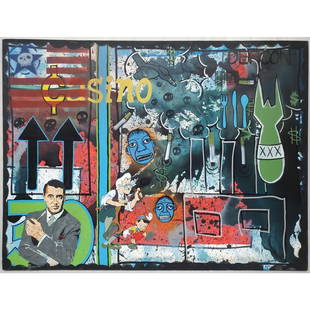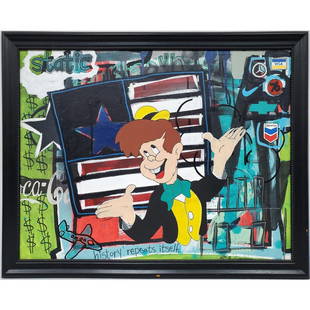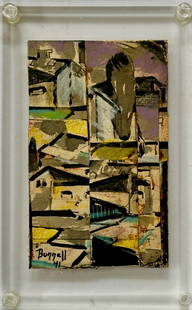
Fonseca, Harry (American, 1946-2006) Painting
Similar Sale History
View More Items in Mixed Media & CollagesRelated Mixed Media & Collages
More Items in American Mixed Media & Collages
View MoreRecommended Art
View More







Item Details
Description
Fonseca, Harry (American, 1946-2006) Acrylic Painting. “Coyote Koshare Smoken.” Acrylic and glitter on canvas. Signed lower right Fonseca. Retains The Elaine Horwitch Galleries Scottsdale Santa Fe label on reverse with artist’s name and title. In good condition. Measures 11 ” x 8 ”. Frame measures 11 ” x 9 ”.
From: harryfonseca.com/news/index.htm: Fonseca was born in Sacramento, California in 1946, and is of Nisenan Maidu, Hawaiian, and Portugese heritage. He studied for a time at Sacramento City College and with Frank LaPena at Cal State University at Sacramento, but was reluctant to become an academic stylist, so he decided not to continue formal art education in order to pursue his own vision. In his close to twenty-year career as an exhibiting artist, Harry Fonseca's work has gone through a number of transformations, but the one constant has been his openness to new influences and sources of inspiration. Fonseca's earliest pieces drew from his Maidu heritage. He was influenced by basketry designs, dance regalia, and by his participation as a traditional dancer. Further, the creation myth of his people, as recounted by his uncle, Henry Azbill, became the source of a major 1977 work, Creation Story. This piece visually embodies the underpinnings of Maidu culture. Margaret Archuleta has noted that the work is a pictorially complex sequence set in a spiral motif. The central focal point is Helinmaiden, the Maidu Big Man, Great Man, or God, as he appears on the raft with Turtle. The continuing pencil and ink drawings are linked together as they rotate in a clockwise movement around the central axis of Helinmaiden, whose importance is expressed by his central placement. The spiral design echoes the cyclical rhythm of the storytelling in connection with the seasonal celebrations. This myth continues to inspire Fonseca, as his 1991 The Maidu Creation Story shows. The basic imagery of this painting recalls petroglyphic symbols, and although less figurative than the 1979 work, still seeks to give visual form to myth. Fonseca does not replicate his past imagery but looks for new ways of connecting to tradition. Regarding the 1991 work, Darryl Wilson has pointed out that Fonseca "was particularly struck by ancient rock art from the Coso Range in the high desert country near Owens Lake [north of Ridgecrest, California]. Because of its powerful appeal, he incorporated some of its images into the similarly powerful and appealing creation story Henry Azbill told him. Another level of transformation is evident in the Coyote series, which Fonseca began in 1979 (and which, after a few years' hiatus, he has started again). The subject of these works is Coyote, the trickster and transformer. Fonseca resituates the culture hero into contemporary settings, such as San Francisco's Mission District. Coyote can become an updated and sneaker-wearing Rousseau, holding his palette on a Parisian quay (Rousseau Revisited, 1986), or headdress-clad and sneakered (Coyote in Front of Studio, 1983). Coyote becomes an alembic through which Fonseca filters his vision of the artist, and the Indian, in society. Fonseca's continuing interest in rock art led him to develop the Stone Poems, an extensive series of works exploring the imagery of petroglyphs, not only from California but throughout the West and Southwest, especially Utah. The Stone Poems are not meant to be so much an interpretive recording of rock images but a way of self-exploration. The canvases, some as large as 6' by 12', suggest the size and scope of petroglyphic panels in situ. Fonseca's work took a more political turn with the 1992 Discovery of Gold and Souls in California series. Each of these small mixed-media pieces, measuring about 15" x 11", offer subtle variations on the image of a black cross surrounded by gold leaf and partially covered with red oxide. Fonseca has stated that this series "is a direct reference to the physical, emotional and spiritual genocide of the native people of California. With the rise of the mission system, and much later the discovery of gold in California, the native world was fractured, and with it, a way of life and order devastated." Askart.com: A painter of ethnic symbols related to contemporary storytelling of his 19th century Maidu ancestors, a gatherer tribe of central California, Harry Fonseca is known for what is described as primitive art. Both his subjects and his methods are unique among his peers. One of his series called "Stone Poems," he made from yards of canvas and painted with house paint brushes and oxide-red colors. In his paintings, he frequently has coyotes, a subject he finds psychologically challenging including the relationship to the trickster figure in Indian religions. Other subjects relate to social-justice concerns, his sheer love of beauty, and his reverence for certain religious figures including meditations on Saint Francis. His parents, raising him in Bryte, California, had little understanding of this seemingly impractical pursuit to which he aspired. His father of Portuguese descent was a janitor, and his mother, a blend of Hawaiian and Maidu, was a traditional housewife and mother. In this environment, Fonseca grew up with few books and little exposure to art, but involved himself in this subject while attending college in Sacramento. He was especially interested in the art of Africa, Latin America, and the South Pacific and later became fascinated by petroglyphs when he visited a painted rock cave near Sacramento. He loved their color and designs and sense of playfulness. In 1978, fascinated by the multi-ethnic culture, Fonseca settled in Santa Fe, New Mexico. He donated his archives from 1960 to 1990 to the Heard Museum, which has an extensive artist's file in its Native American Artists Resource Collection, as well as many of his works. Harry Fonseca died on December 28, 2006.
From: harryfonseca.com/news/index.htm: Fonseca was born in Sacramento, California in 1946, and is of Nisenan Maidu, Hawaiian, and Portugese heritage. He studied for a time at Sacramento City College and with Frank LaPena at Cal State University at Sacramento, but was reluctant to become an academic stylist, so he decided not to continue formal art education in order to pursue his own vision. In his close to twenty-year career as an exhibiting artist, Harry Fonseca's work has gone through a number of transformations, but the one constant has been his openness to new influences and sources of inspiration. Fonseca's earliest pieces drew from his Maidu heritage. He was influenced by basketry designs, dance regalia, and by his participation as a traditional dancer. Further, the creation myth of his people, as recounted by his uncle, Henry Azbill, became the source of a major 1977 work, Creation Story. This piece visually embodies the underpinnings of Maidu culture. Margaret Archuleta has noted that the work is a pictorially complex sequence set in a spiral motif. The central focal point is Helinmaiden, the Maidu Big Man, Great Man, or God, as he appears on the raft with Turtle. The continuing pencil and ink drawings are linked together as they rotate in a clockwise movement around the central axis of Helinmaiden, whose importance is expressed by his central placement. The spiral design echoes the cyclical rhythm of the storytelling in connection with the seasonal celebrations. This myth continues to inspire Fonseca, as his 1991 The Maidu Creation Story shows. The basic imagery of this painting recalls petroglyphic symbols, and although less figurative than the 1979 work, still seeks to give visual form to myth. Fonseca does not replicate his past imagery but looks for new ways of connecting to tradition. Regarding the 1991 work, Darryl Wilson has pointed out that Fonseca "was particularly struck by ancient rock art from the Coso Range in the high desert country near Owens Lake [north of Ridgecrest, California]. Because of its powerful appeal, he incorporated some of its images into the similarly powerful and appealing creation story Henry Azbill told him. Another level of transformation is evident in the Coyote series, which Fonseca began in 1979 (and which, after a few years' hiatus, he has started again). The subject of these works is Coyote, the trickster and transformer. Fonseca resituates the culture hero into contemporary settings, such as San Francisco's Mission District. Coyote can become an updated and sneaker-wearing Rousseau, holding his palette on a Parisian quay (Rousseau Revisited, 1986), or headdress-clad and sneakered (Coyote in Front of Studio, 1983). Coyote becomes an alembic through which Fonseca filters his vision of the artist, and the Indian, in society. Fonseca's continuing interest in rock art led him to develop the Stone Poems, an extensive series of works exploring the imagery of petroglyphs, not only from California but throughout the West and Southwest, especially Utah. The Stone Poems are not meant to be so much an interpretive recording of rock images but a way of self-exploration. The canvases, some as large as 6' by 12', suggest the size and scope of petroglyphic panels in situ. Fonseca's work took a more political turn with the 1992 Discovery of Gold and Souls in California series. Each of these small mixed-media pieces, measuring about 15" x 11", offer subtle variations on the image of a black cross surrounded by gold leaf and partially covered with red oxide. Fonseca has stated that this series "is a direct reference to the physical, emotional and spiritual genocide of the native people of California. With the rise of the mission system, and much later the discovery of gold in California, the native world was fractured, and with it, a way of life and order devastated." Askart.com: A painter of ethnic symbols related to contemporary storytelling of his 19th century Maidu ancestors, a gatherer tribe of central California, Harry Fonseca is known for what is described as primitive art. Both his subjects and his methods are unique among his peers. One of his series called "Stone Poems," he made from yards of canvas and painted with house paint brushes and oxide-red colors. In his paintings, he frequently has coyotes, a subject he finds psychologically challenging including the relationship to the trickster figure in Indian religions. Other subjects relate to social-justice concerns, his sheer love of beauty, and his reverence for certain religious figures including meditations on Saint Francis. His parents, raising him in Bryte, California, had little understanding of this seemingly impractical pursuit to which he aspired. His father of Portuguese descent was a janitor, and his mother, a blend of Hawaiian and Maidu, was a traditional housewife and mother. In this environment, Fonseca grew up with few books and little exposure to art, but involved himself in this subject while attending college in Sacramento. He was especially interested in the art of Africa, Latin America, and the South Pacific and later became fascinated by petroglyphs when he visited a painted rock cave near Sacramento. He loved their color and designs and sense of playfulness. In 1978, fascinated by the multi-ethnic culture, Fonseca settled in Santa Fe, New Mexico. He donated his archives from 1960 to 1990 to the Heard Museum, which has an extensive artist's file in its Native American Artists Resource Collection, as well as many of his works. Harry Fonseca died on December 28, 2006.
Buyer's Premium
- 18%
Fonseca, Harry (American, 1946-2006) Painting
Estimate $600 - $900
8 bidders are watching this item.
Shipping & Pickup Options
Item located in St. Petersburg, FL, usSee Policy for Shipping
Payment

TOP














































































